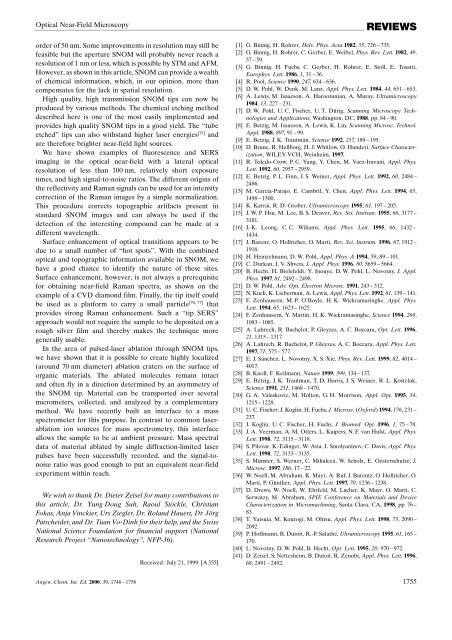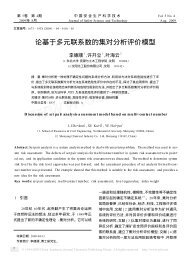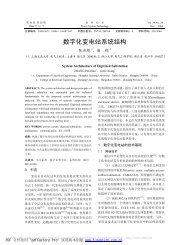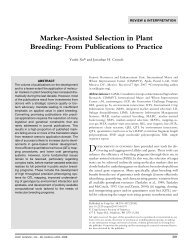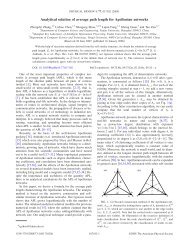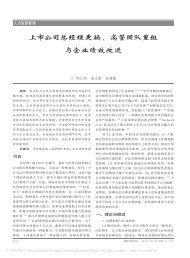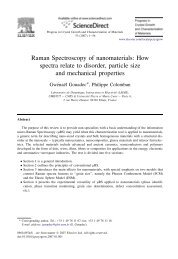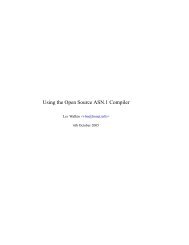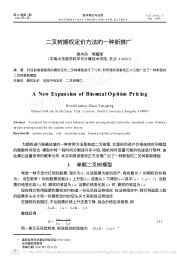Scanning Near-Field Optical Microscopy and Spectroscopy as a ...
Scanning Near-Field Optical Microscopy and Spectroscopy as a ...
Scanning Near-Field Optical Microscopy and Spectroscopy as a ...
Create successful ePaper yourself
Turn your PDF publications into a flip-book with our unique Google optimized e-Paper software.
<strong>Optical</strong> <strong>Near</strong>-<strong>Field</strong> <strong>Microscopy</strong>order of 50 nm. Some improvements in resolution may still befe<strong>as</strong>ible but the aperture SNOM will probably never reach aresolution of 1 nm or less, which is possible by STM <strong>and</strong> AFM.However, <strong>as</strong> shown in this article, SNOM can provide a wealthof chemical information, which, in our opinion, more thancompensates for the lack in spatial resolution.High quality, high transmission SNOM tips can now beproduced by various methods. The chemical etching methoddescribed here is one of the most e<strong>as</strong>ily implemented <strong>and</strong>provides high quality SNOM tips in a good yield. The ªtubeetchedº tips can also withst<strong>and</strong> higher l<strong>as</strong>er energies [75] <strong>and</strong>are therefore brighter near-field light sources.We have shown examples of fluorescence <strong>and</strong> SERSimaging in the optical near-field with a lateral opticalresolution of less than 100 nm, relatively short exposuretimes, <strong>and</strong> high signal-to-noise ratios. The different origins ofthe reflectivity <strong>and</strong> Raman signals can be used for an intensitycorrection of the Raman images by a simple normalization.This procedure corrects topographic artifacts present inst<strong>and</strong>ard SNOM images <strong>and</strong> can always be used if thedetection of the interesting compound can be made at adifferent wavelength.Surface enhancement of optical transitions appears to bedue to a small number of ªhot spotsº. With the combinedoptical <strong>and</strong> topographic information available in SNOM, wehave a good chance to identify the nature of these sites.Surface enhancement, however, is not always a prerequisitefor obtaining near-field Raman spectra, <strong>as</strong> shown on theexample of a CVD diamond film. Finally, the tip itself could[76, 77]be used <strong>as</strong> a platform to carry a small particle thatprovides strong Raman enhancement. Such a ªtip SERSºapproach would not require the sample to be deposited on arough silver film <strong>and</strong> thereby makes the technique moregenerally usable.In the area of pulsed-l<strong>as</strong>er ablation through SNOM tips,we have shown that it is possible to create highly localized(around 70 nm diameter) ablation craters on the surface oforganic materials. The ablated molecules remain intact<strong>and</strong> often fly in a direction determined by an <strong>as</strong>ymmetry ofthe SNOM tip. Material can be transported over severalmicrometers, collected, <strong>and</strong> analyzed by a complementarymethod. We have recently built an interface to a m<strong>as</strong>sspectrometer for this purpose. In contr<strong>as</strong>t to common l<strong>as</strong>erablationion sources for m<strong>as</strong>s spectrometry, this interfaceallows the sample to be at ambient pressure. M<strong>as</strong>s spectraldata of material ablated by single diffraction-limited l<strong>as</strong>erpulses have been successfully recorded, <strong>and</strong> the signal-tonoiseratio w<strong>as</strong> good enough to put an equivalent near-fieldexperiment within reach.We wish to thank Dr. Dieter Zeisel for many contributions tothis article, Dr. Yung Doug Suh, Raoul Stöckle, ChristianFok<strong>as</strong>, Anja Vinckier, Urs Ziegler, Dr. Rol<strong>and</strong> Hauert, Dr. JörgPatscheider, <strong>and</strong> Dr. Tuan Vo-Dinh for their help, <strong>and</strong> the SwissNational Science Foundation for financial support (NationalResearch Project ªNanotechnologyº, NFP-36).Received: July 21, 1999 [A 355]REVIEWS[1] G. Binnig, H. Rohrer, Helv. Phys. Acta 1982, 55, 726 ± 735.[2] G. Binnig, H. Rohrer, C. Gerber, E. Weibel, Phys. Rev. Lett. 1982, 49,57 ± 59.[3] G. Binnig, H. Fuchs, C. Gerber, H. Rohrer, E. Stoll, E. Tosatti,Europhys. Lett. 1986, 1, 31 ± 36.[4] R. Pool, Science 1990, 247, 634 ± 636.[5] D. W. Pohl, W. Denk, M. Lanz, Appl. Phys. Lett. 1984, 44, 651 ± 653.[6] A. Lewis, M. Isaacson, A. Harootunian, A. Muray, Ultramicroscopy1984, 13, 227 ± 231.[7] D. W. Pohl, U. C. Fischer, U. T. Dürig, <strong>Scanning</strong> <strong>Microscopy</strong> Technologies<strong>and</strong> Applications, W<strong>as</strong>hington, DC, 1988, pp. 84 ± 90.[8] E. Betzig, M. Isaacson, A. Lewis, K. Lin, <strong>Scanning</strong> Microsc. Technol.Appl. 1988, 897, 91 ± 99.[9] E. Betzig, J. K. Trautman, Science 1992, 257, 189 ± 195.[10] D. Brune, R. Hellborg, H. J. Whitlow, O. Hunderi, Surface Characterization,WILEY-VCH, Weinheim, 1997.[11] R. Toledo-Crow, P. C. Yang, Y. Chen, M. Vaez-Iravani, Appl. Phys.Lett. 1992, 60, 2957 ± 2959.[12] E. Betzig, P. L. Finn, J. S. Weiner, Appl. Phys. Lett. 1992, 60, 2484 ±2486.[13] M. Garcia-Parajo, E. Cambril, Y. Chen, Appl. Phys. Lett. 1994, 65,1498 ± 1500.[14] K. Karrai, R. D. Grober, Ultramicroscopy 1995, 61, 197 ± 205.[15] J. W. P. Hsu, M. Lee, B. S. Deaver, Rev. Sci. Instrum. 1995, 66, 3177 ±3181.[16] J.-K. Leong, C. C. Wiliams, Appl. Phys. Lett. 1995, 66, 1432 ±1434.[17] J. Barenz, O. Hollricher, O. Marti, Rev. Sci. Instrum. 1996, 67, 1912 ±1916.[18] H. Heinzelmann, D. W. Pohl, Appl. Phys. A 1994, 59, 89 ± 101.[19] C. Durkan, I. V. Shvets, J. Appl. Phys. 1996, 80, 5659 ± 5664.[20] B. Hecht, H. Bielefeldt, Y. Inouye, D. W. Pohl, L. Novotny, J. Appl.Phys. 1997, 81, 2492 ± 2498.[21] D. W. Pohl, Adv. Opt. Electron Microsc. 1991, 243 ± 312.[22] N. Kuck, K. Lieberman, A. Lewis, Appl. Phys. Lett. 1992, 61, 139 ± 141.[23] F. Zenhausern, M. P. OBoyle, H. K. Wickram<strong>as</strong>inghe, Appl. Phys.Lett. 1994, 65, 1623 ± 1625.[24] F. Zenhausern, Y. Martin, H. K. Wickram<strong>as</strong>inghe, Science 1994, 269,1083 ± 1085.[25] A. Lahrech, R. Bachelot, P. Gleyzes, A. C. Boccara, Opt. Lett. 1996,21, 1315 ± 1317.[26] A. Lahrech, R. Bachelot, P. Gleyzes, A. C. Boccara, Appl. Phys. Lett.1997, 71, 575 ± 577.[27] E. J. SaÂnchez, L. Novotny, X. S. Xie, Phys. Rev. Lett. 1999, 82, 4014 ±4017.[28] B. Knoll, F. Keilmann, Nature 1999, 399, 134 ± 137.[29] E. Betzig, J. K. Trautman, T. D. Harris, J. S. Weiner, R. L. Kostelak,Science 1991, 251, 1468 ± 1470.[30] G. A. Val<strong>as</strong>kovic, M. Holton, G. H. Morrison, Appl. Opt. 1995, 34,1215 ± 1228.[31] U. C. Fischer, J. Koglin, H. Fuchs, J. Microsc. (Oxford) 1994, 176, 231 ±237.[32] J. Koglin, U. C. Fischer, H. Fuchs, J. Biomed. Opt. 1996, 1, 75 ± 78.[33] J. A. Veerman, A. M. Otters, L. Kuipers, N. F. van Hulst, Appl. Phys.Lett. 1998, 72, 3115 ± 3118.[34] S. Pilevar, K. Edinger, W. Atia, I. Smolyaninov, C. Davis, Appl. Phys.Lett. 1998, 72, 3133 ± 3135.[35] S. Münster, S. Werner, C. Mihalcea, W. Scholz, E. Oesterschulze, J.Microsc. 1997, 186, 17 ± 22.[36] W. Noell, M. Abraham, K. Mayr, A. Ruf, J. Barentz, O. Hollricher, O.Marti, P. Günther, Appl. Phys. Lett. 1997, 70, 1236 ± 1238.[37] D. Drews, W. Noell, W. Ehrfeld, M. Lacher, K. Mayr, O. Marti, C.Serwatzy, M. Abraham, SPIE Conference on Materials <strong>and</strong> DeviceCharacterization in Micromachining, Santa Clara, CA, 1998, pp. 76 ±83.[38] T. Yatsuia, M. Kourogi, M. Ohtsu, Appl. Phys. Lett. 1998, 73, 2090 ±2092.[39] P. Hoffmann, B. Dutoit, R.-P. SalatheÂ, Ultramicroscopy 1995, 61, 165 ±170.[40] L. Novotny, D. W. Pohl, B. Hecht, Opt. Lett. 1995, 20, 970 ± 972.[41] D. Zeisel, S. Nettesheim, B. Dutoit, R. Zenobi, Appl. Phys. Lett. 1996,68, 2491 ± 2492.Angew. Chem. Int. Ed. 2000, 39, 1746 ± 1756 1755


